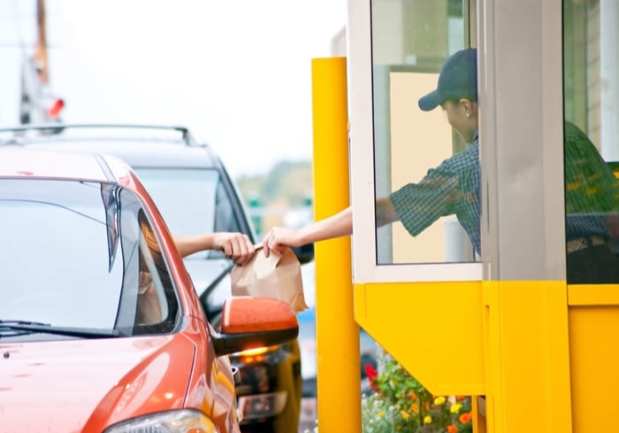How Digital Disruptors Are Taking On The QSR Drive-Thru

Some digital innovators reinvent old processes to make them more efficient. Daniel McCann, who started restaurant customer engagement platform 5thru, for instance, turned his focus to the long wait at the drive-thru. Consumers might want to get a morning cup of coffee, but face a drive-thru line that is, say, 17 cars long, causing them to abandon the order. McCann thought there must be a better way to place an order, and “began to look for inefficiencies in the system,” he told PYMNTS in an interview.
To tackle those inefficiencies, McCann created a technology platform that seeks to enhance the drive-thru experience. When a customer arrives, a camera scans the driver’s license plate to start a customer profile (similar, in a sense, to how consumers might pay by plate at a toll). A screen inside the business then shows a customer profile with past order history, along with new product recommendations. For even faster service, payments can also be automated. (The attendant will ask customers if they want to keep their cards on file, and they can be used at other locations if they opt in.)
Historically, drive-thrus have been anonymous (cue the “do you want fries with that?”), but technology that can scan license plates might change that, resulting in what McCann described as “a complete rethink of the drive-thru.” If restaurants can know their customers, he said, “they can engage them in a totally different way.” 5thru can use artificial intelligence (AI) to provide a unique experience. (For example, it wouldn’t make sense for a restaurant to recommend an iced drink in a Northeastern U.S. state in the winter, but chili might fit the bill.)
The technology could also help customize orders to the individual customers’ dietary needs. For example, while a restaurant might typically recommend a chicken burger, that suggestion would not be applicable to someone who is vegetarian. By knowing this information about the customer, the restaurant can recommend a salad or veggie burger instead.
McCann noted that the restaurant employees don’t have to think through the upsell, as the AI system does the hard work for them. “All the heavy lifting is done in the backend by our software,” he said.
The QSR Innovation Market
5thru is not the only company looking to help restaurants customize the QSR experience for diners. AI-powered personalization platform operator Dynamic Yield announced in March that it was being acquired by McDonald’s. The restaurant chain will reportedly deploy the company’s technology in its outdoor digital drive-thru menu displays in addition to its self-order kiosks and on its app.
Dynamic Yield Chief Executive Liad Agmon wrote in a blog post at the time, “Our acquisition by McDonald’s, one of the most iconic and beloved brands of our time, is truly an endorsement of that vision, as they have chosen Dynamic Yield to help power personalization across their 37,000 restaurants in 120+ markets around the world.” As of the report, it was noted that Dynamic Yield now enables more than 300 brands in six continents, including in gaming, retail, finance, travel and publishing.
When it comes to innovations, QSR managers have two major motives: speed and improving their customers’ experiences. According to the PYMNTS Restaurant Readiness Index, nearly eight in 10 – or 77.4 percent – of managers view new innovations as boosting speed. Approximately the same share – or 74.4 percent – noted that they view innovations as improving customer experiences. A slightly smaller share – 62.4 percent – see innovations as adding convenience.
With the help of AI technology, startups are looking to change the way restaurants personalize the drive-thru experience with payments and upsells – a formula that could potentially appeal to QSRs.
